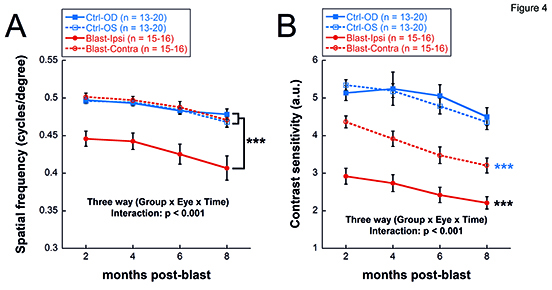Visual impairments resulting from exposure to explosive blasts often develop weeks, months, or even years after the injury. However, many blast injury studies involving animals only investigate visual symptoms within the first few days to weeks of injury, when the symptoms have not emerged or are just starting to emerge. To help close this knowledge gap, Dr. Rachael Allen and her colleagues at Atlanta Veteran Affairs (VA) Medical Center, Georgia Institute of Technology, State University of New York at Buffalo, and VA Western New York Healthcare System collaborated to characterize in a rat model the structural and functional changes in the retina and associated visual impairments that occur in the chronic phase after blast exposure.
The collaborative study entailed exposing rats to a sonic shock wave– "acoustic blast overpressure" (ABO)– using a modified shock tube originally designed to study blast-related auditory injury, with their heads positioned perpendicularly to the blast. Retinal characteristics of the ipsilateral (on the same side as the blast) and the contralateral (away from the blast) eyes were examined up to eight months post-blast. The group looked for changes in retinal structure and visual function.
Evaluation of retinal structure revealed an increase in retinal thickness in response to blast due to changes in multiple layers of the retina. Changes were also observed in distribution of the glial cell marker, GFAP (glial fibrillary acidic protein). GFAP is a structural protein normally found only in the inner-most layers of the retina directly adjacent to the vitreous. However, after blast exposure, GFAP was detected in deeper retinal layers in both ipsilateral and, to a lesser extent, contralateral eyes during the chronic injury phase post-blast.
Exposure to sonic blast also resulted in changes in visual function as well. Electroretinogram (ERG) waveforms– a measure of the retina’s electrical response to light– showed that the electrical responses were greater in both eyes up to eight months post-blast compared to the eyes of non-blast-exposed (control) animals. Electrical signaling of the retina was also found to be delayed in the chronic phase post-blast. In addition, visual sensitivity was lower in blast-exposed animals compared to controls, starting two months post-blast, and continued to deteriorate over time.
Allen and colleagues use a modified ABO model to characterize the impairments in retinal function that occur in the chronic phase after injury. These findings suggest that a more comprehensive visual examination could potentially diagnose blast-associated injury in military Service members months after the initiating event. Additionally, the study highlights the potential use of the ABO model to characterize mechanisms underlying retinal blast injury and to guide the development and evaluation of novel therapeutics for blast injury.

Your 15 minute session will timeout in approximately 10 minutes.
If you're in the middle of entering information, please close this warning and save your progress (if possible) or finish up your task.
If your session fully times out, you will lose any un-saved work.
Your current Blast Injury Research Program session has expired.
Your next click will take you away from the private area, and you will lose any work you have in-progress.
Please enter your email address, and try again.